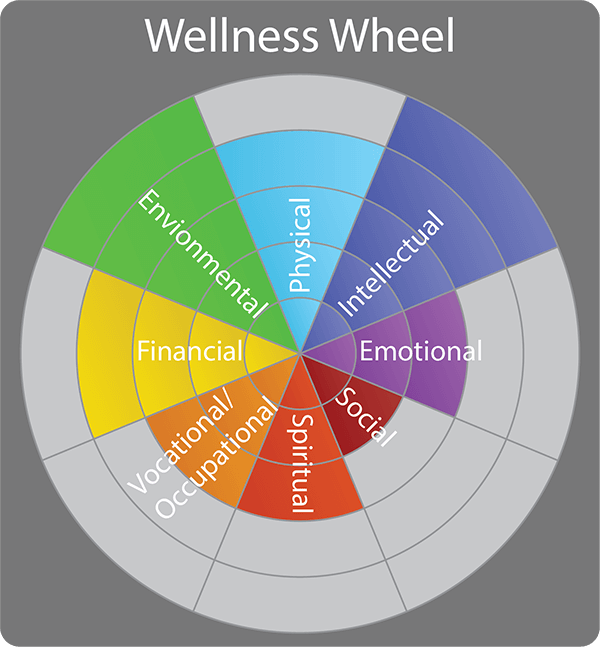Measures of Wellness
See also: Wellness Testing and TrackingThe rapid expansion in the use of ‘wearables’ such as smart watches has given us all new tools to track our health and fitness, and measure ‘wellness’. We can measure our heart rates, steps, and sleep, and even count the number of flights of stairs we walk up and down each day. These measures join more established systems such as blood pressure, waist circumference and body mass index (BMI) for assessing health.
However, do these measures provide useful information about health, or are they just numbers? This page examines the concept of ‘wellness’. It also discusses some of the available measures, both objective and subjective, that can be used to assess wellness on an individual basis.
What is Wellness?
There is no single agreed definition of wellness. However, there are a number of concepts that seem to be shared by many of the possible definitions (see box).
Defining wellness
Wellness is... “the active pursuit of activities, choices and lifestyles that lead to a state of holistic health.”
Global Wellness Institute
“Wellness is the act of practicing healthy habits on a daily basis to attain better physical and mental health outcomes, so that instead of just surviving, you’re thriving.”
Pfizer.com
“Wellness is fueling your body, engaging your mind, and nurturing your spirit.”
University of Maryland, Your Guide to Living Well
These include the idea that wellness is more than physical health, but also includes psychological and even spiritual well-being. Merriam-Webster suggests that the term is particularly used in the context of a state that is actively sought, and this certainly fits with the definitions in the box.
Dimensions of Wellness
There is also general agreement that there are several possible dimensions of wellness. The consensus seems to have settled on eight:
Physical: Looking after your body so that you stay healthy both now and in the future.
You can find out more about how to do this in our pages on Caring for Your Body.
Intellectual: Looking after your mind, so that you stay curious and intellectually alert, and keep learning.
There is more about this in our pages on Keeping Your Mind Healthy and Learning Skills.
Emotional: Understanding and managing your own feelings and values, and being able to respond appropriately to those of others.
There is more about this in our pages on Emotional Intelligence.
Social: Developing and maintaining healthy relationships with other people, and contributing appropriately to your community.
You can learn more about these skills in our page on Social Skills in Emotional Intelligence and Interpersonal Skills.
-
Spiritual: Finding purpose and meaning in your life, through understanding your values and beliefs, and using them to guide you through life.
You can find out more about the nature of belief in our page on Dilts Logical Levels, and how to discover your values in our page on Career Management: Discovering Your Values.
-
Vocational/Occupational: Finding work that provides personal satisfaction and a life that is consistent with your values and wishes.
You can find out more about how you might do this in our pages on Career Management Skills.
-
Financial: Managing your resources so that you live within your means and are able to deal with short- and long-term financial issues.
You can learn more about the skills required in our pages on Money Management and Financial Skills.
-
Environmental: Understanding your impact on the planet, and the impact of the environment on your mental and physical health.
You may be interested to read our pages on Sustainability to find out more.
Source: Stoewen, D. L. (2017). Dimensions of wellness: Change your habits, change your life. Canadian Veterinary Journal, 58(8), 861–862.
Tools and Measures for Wellness
There are many different tools and measures for wellness. These may be either objective or subjective.
Objective Measures of Wellness
Objective measures of wellness fall into three main types: physical measures, biomarkers and behavioural measures.
Physical measures of wellness include:
-
Body mass index (BMI). This is a measure of whether you are the ‘right’ weight for your height. There are many issues with it, but it is widely used because it is simple to calculate, and requires no specialist equipment. You can find out more in our page on BMI.
Waist circumference. People with a larger waist circumference have a higher risk of mortality from cardiovascular disease, and this is independent of their BMI. This measure is therefore used by clinicians as a broad measure of cardiovascular risk and therefore health.
Body fat percentage. This can be estimated from other measures like BMI, or it can be measured directly using scans. There is evidence that people with a higher body fat percentage tend to be less healthy, and this is again regardless of BMI.
Blood biomarkers used to measure wellness include:
Fasting blood glucose levels give an indication of whether you are diabetic or pre-diabetic. They therefore provide useful information for making changes to your diet and lifestyle to avoid becoming ill.
Cholesterol levels are a proxy for general heart health, and the risk of heart disease.
-
Vitamin D levels may affect many aspects of health, because Vitamin D is important in various metabolic processes. You can find out more in our page on Vitamins.
The levels of various hormones can provide information about several aspects of health. However, interpreting tests can be difficult, because it is not always clear what the optimal level is for any individual at any particular point in their life.
All these are assessed through analysis of a blood sample, which may be either from a pinprick at home, or taken by a phlebotomist.
Behavioural measures of wellness include:
Sleep duration and quality. Sleep is an important contributor to general health (and there is more about this in our page on What is Sleep?).
Wellness trackers such as smart watches often track sleep. However, they are only able to measure sleep by your general movement: if you are someone who thrashes around in bed, you may find that your tracker thinks you have slept badly. Conversely, if you lie awake but still, your tracker is likely to think you are asleep.
There is more about this in our pages on Fitness Trackers and Wellness Testing and Tracking.
-
Dietary intake and calorie use. Diet has a considerable impact on your general wellness (and you can find out more in our pages on Food, Diet and Nutrition). You might be asked to track your food intake through a food diary, for example, if there are concerns that you have a food allergy or intolerance.
Fitness trackers also often provide a measure of how much energy you are using each day in the form of calories.
Accuracy not included
Your fitness tracker’s information about your calorie use should NOT in any way be considered accurate. Your tracker has no idea of your base metabolic rate, so the calculation is based on an average for your age and sex, provided you have given it that information.
This information is tempting, because it is in a form we understand. It draws on the old idea that you need to balance calories in and calories out. However, we now know that this is far too simplistic, and will not help you to either eat healthily, or lose weight if that is what you want.
There is more about this in our pages on Dieting for Weight Loss and Calorie Counting and Food Labelling.
-
Exercise. Fitness trackers can show you how many hours of exercise you have taken in a given period, and also estimate the intensity. This can be helpful—but again, it may not be completely accurate, especially on the intensity. There is more about this issue in our page on Using Fitness Trackers.
Subjective measures of wellness
There are many different subjective measures of wellness.
For example, a review of articles on measures of wellness in clinical settings found 11 different instruments for that purpose. All of them used survey questionnaires, either with an administrator or self-completed. These are therefore completely subjective, although some of them have been found to be very reliable. They are also time-consuming to complete.
An alternative that is much quicker to complete is a wellness wheel (see diagram below).
This shows the eight dimensions of wellness around a wheel. You complete it by scoring each one out of 5, and colouring in the required number of boxes to show your level of general happiness and satisfaction with that area of your life.

This is useful because it gives you a quick and very visual summary of how you feel about each area of your life. You can therefore use it to see where you might need to make a bit more effort. However, it is important to recognise that it is only showing your own feelings—and tomorrow you might feel very differently.
A Final Thought
Wellness is a multifaceted concept.
It is probably impossible to be entirely satisfied with every area or dimension at any given time. You might therefore ask whether there is much point in measuring wellness—and that is not a wholly unreasonable question. Perhaps the point is more to understand that any single measure can only give a snapshot and will not be a holistic picture. Taken together, multiple measures can give a more complete picture—but even then, you may need help to interpret it, and decide whether you need to take any action.

